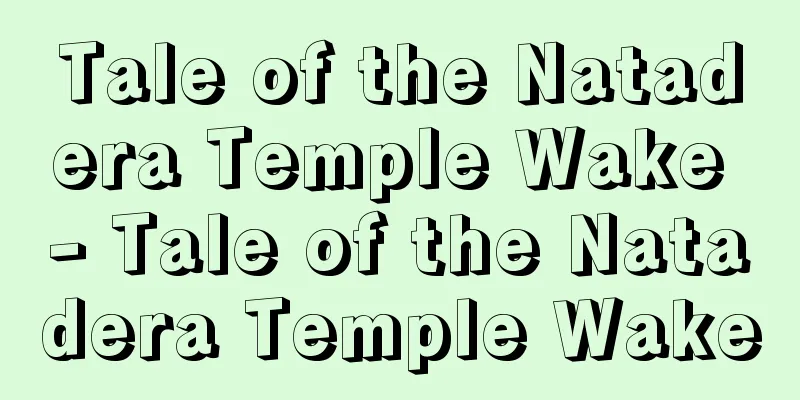Bengal - Bengal (English spelling)

|
The name of a region in the northeastern part of the Indian subcontinent. It consists of the Indian state of West Bengal and Bangladesh. The main cities in India are Kolkata (Calcutta) and in Bangladesh are Dhaka. Locals pronounce the name as "Bengal", and "Bangladesh" means the land where Bengalis live. It is sometimes called "Golden Bengal" due to the fertile land in the lower Ganges delta. It produces a lot of rice and jute, and more than 90% of the population are Bengali, who belong to the Indo-European language family. [Kitagawa Kenji] historyThis region is the eastern edge of the Indo-Aryan settlements, and the inhabitants are still strongly influenced by non-Aryan elements such as Mongoloids and Dravidians. After the collapse of the Gupta Empire in the first half of the 6th century, the Pala dynasty, which supported Buddhism, achieved unification in the mid-8th century. In the mid-12th century, the Sena dynasty, which invaded from South India, overthrew them, restored orthodox Hinduism, and established the caste system. In the early 13th century, Afghan Muslim forces conquered Bengal, and the Mughal Empire continued to rule the region under Muslim rule from the late 16th century to the late 18th century. From the late 16th century, Portugal, the Netherlands, France, and Britain established trading posts in search of raw silk, silk cloth, and cotton cloth produced in the region. In 1765, the British East India Company acquired effective sovereignty over Bengal, and the region's abundant tax revenues became an important source of finance for the subsequent British conquest of India. From this time until its partition and independence in 1947, it was the largest base for colonial economic exploitation of India. [Shinichi Taniguchi] Source: Shogakukan Encyclopedia Nipponica About Encyclopedia Nipponica Information | Legend |
|
インド亜大陸北東部の地方名。インドの西ベンガル州とバングラデシュからなる。インドではコルカタ(カルカッタ)、バングラデシュではダッカが中心的な都市である。土地の人はベンゴールと発音し、「バングラデシュ」はベンガル人の住む土地を意味する。ガンジス川下流デルタ一帯の豊かな土地で、「黄金のベンガル」とよばれることもある。米、ジュートの生産が多く、住民は、インド・ヨーロッパ語系に属するベンガル人が人口の90%以上を占める。 [北川建次] 歴史この地方は、インド・アーリア人の定住地の東端をなし、住民にはモンゴロイド、ドラビダなど非アーリア系要素が色濃く残っている。6世紀前半のグプタ帝国の崩壊後、8世紀中ごろに仏教を支持するパーラ朝が統一を達成した。12世紀中ごろ、南インドから侵入したセーナ朝がこれを倒し、正統ヒンドゥー教を復活させ、カースト制度を確立した。13世紀初頭、アフガン系イスラム教勢力がベンガルを征服し、ついで16世紀後半~18世紀後半までムガル帝国によりイスラム教徒支配が続いた。16世紀後半から、この地に産する生糸、絹布、綿布などを求めてポルトガル、オランダ、フランス、イギリスの各国が商館を設立した。1765年イギリス東インド会社がベンガルの実質的な領有権を獲得し、この地の豊かな税収はその後のイギリスのインド征服の重要な財源となった。こののち、1947年の分離独立まで、インドの植民地的経済搾取の最大の拠点であった。 [谷口晋吉] 出典 小学館 日本大百科全書(ニッポニカ)日本大百科全書(ニッポニカ)について 情報 | 凡例 |
<<: Bengali - Bengalgo (English spelling) Bengali
>>: Bengara (red stone, red shell) - Bengara
Recommend
Symplocos
…An evergreen shrub or small tree (illustration) ...
Hirotari Nakajima
Year of death: 21st January, 1864 (28th February, ...
Waqf (English spelling)
An Arabic word meaning state land for the Islamic ...
Makeup - Kesho
It mainly refers to putting on rouge or powder on...
Rostislav
...The territory of this state, which lasted for ...
Gardere
Argentine tango singer. His hit song "My Sorr...
al-Ḍabbī (English spelling)
?-1203 A 12th-century Andalusian scholar. Much abo...
Actinic keratosis
...In rare cases, exposure to ultraviolet light, ...
Mr. Aizo - Aizouji
…A samurai family in Ise from the Northern and So...
Numazu Military Academy
This educational institution for Western studies ...
rozhok
...The bagpipe version is called the dutka or vol...
Cobalt metal
…In Japan, a unique technology has been developed...
Katowice
The central city of the Upper Silesian industrial ...
Beat - Beat
〘 noun 〙 [1] A word used in music. ① A division in...
Ethylenediamine - Ethylenediamine
An aliphatic amine. Also known as 1,2-diaminoetha...









